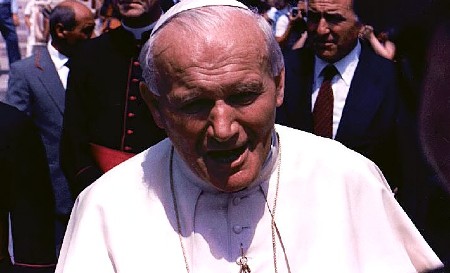Pope's Response to Priests on the Liturgy
FREE Catholic Classes
"We Ourselves Must Interiorize the Structure, the Words"
CASTEL GANDOLFO, Italy, SEPT. 28, 2006 (Zenit) - Here is a translation of the third of five answers that Benedict XVI gave to as many questions from priests of the Diocese of Albano during a meeting Aug. 31 at papal summer residence of Castel Gandolfo. The residence is located in the diocese.
* * *
The Liturgy
Father Vittorio Petruzzi, parochial vicar in Aprilia:
Your Holiness, for the pastoral year that is about to begin, our diocese was asked by the bishop to pay special attention to the liturgy, in the theological dimension and in celebrative practices. The central theme for reflection at the residential weeks in which we shall be taking part in September is "The Planning and Implementation of the Proclamation in the Liturgical Year, in Sacraments and in Sacramentals."
As priests, we are called to celebrate a "serious, simple and beautiful liturgy," to use a beautiful formula contained in the document "Communicating the Gospel in a Changing World" by the Italian bishops. Holy Father, can you help us to understand how all this can be expressed in the "ars celebrandi"?
Benedict XVI:
"Ars celebrandi": here too I would say that there are different dimensions. The first dimension is that the "celebration" is prayer and a conversation with God: God with us and us with God. Thus, the first requirement for a good celebration is that the priest truly enter this colloquy.
In proclaiming the Word, he feels himself in conversation with God. He is a listener to the Word and a preacher of the Word, in the sense that he makes himself an instrument of the Lord and seeks to understand this Word of God which he must then transmit to the people. He is in a conversation with God because the texts of holy Mass are not theatrical scripts or anything like them, but prayers, thanks to which, together with the assembly, I speak to God.
It is important, therefore, to enter into this conversation. St. Benedict in his Rule tells the monks, speaking of the recitation of the Psalms, "Mens concordet voci." The "vox," words, precede our mind. This is not usually the case: One has to think first, then one's thought becomes words. But here, the words come first. The sacred Liturgy gives us the words; we must enter into these words, find a harmony with this reality that precedes us.
In addition, we must also learn to understand the structure of the liturgy and why it is laid out as it is. The liturgy developed in the course of two millenniums and even after the Reformation was not something worked out by simply a few liturgists. It has always remained a continuation of this ongoing growth of worship and proclamation.
Thus, to be well in tune, it is very important to understand this structure that developed over time and to enter with our "mens" into the "vox" of the Church. To the extent that we have interiorized this structure, comprehended this structure, assimilated the words of the liturgy, we can enter into this inner consonance and thus not only speak to God as individuals, but enter into the "we" of the Church, which is praying. And we thus transform our "I" in this way, by entering into the "we" of the Church, enriching and enlarging this "I," praying with the Church, with the words of the Church, truly being in conversation with God.
This is the first condition: We ourselves must interiorize the structure, the words of the liturgy, the Word of God. Thus, our celebration truly becomes a celebration "with" the Church: Our hearts are enlarged and we are not doing just anything but are "with" the Church, in conversation with God. It seems to me that people truly feel that we converse with God, with them, and that in this common prayer we attract others, in communion with the children of God we attract others; or if not, we are only doing something superficial.
Thus, the fundamental element of the true "ars celebrandi" is this consonance, this harmony between what we say with our lips and what we think with our heart. The "Sursum corda," which is a very ancient word of the liturgy, should come before the Preface, before the liturgy, as the "path" for our speaking and thinking. We must raise our heart to the Lord, not only as a ritual response but as an expression of what is happening in this heart that is uplifted, and also lifts up others.
In other words, the "ars celebrandi" is not intended as an invitation to some sort of theater or show, but to an interiority that makes itself felt and becomes acceptable and evident to the people taking part. Only if they see that this is not an exterior or spectacular "ars" -- we are not actors! -- but the expression of the journey of our heart that attracts their hearts too, will the liturgy become beautiful, will it become the communion with the Lord of all who are present.
Of course, external things must also be associated with this fundamental condition, expressed in St. Benedict's words: "Mens concordet voci" -- the heart is truly raised, uplifted to the Lord. We must learn to say the words properly.
Sometimes, when I was still a teacher in my country, young people had read the sacred Scriptures. And they read them as one reads the text of a poem one has not understood. Naturally, to learn to say words correctly one must first understand the text with its drama, with its immediacy. It is the same for the Preface and for the Eucharistic Prayer.
It is difficult for the faithful to follow a text as long as our Eucharistic Prayer. For this reason these new "inventions" are constantly cropping up. However, with constantly new Eucharistic Prayers one does not solve the problem. The problem is that this is a moment that also invites others to silence with God and to pray with God. Therefore, things can only go better if the Eucharistic Prayer is said well and with the correct pauses for silence, if it is said with interiority but also with the art of speaking.
It follows that the recitation of the Eucharistic Prayer requires a moment of special attention if it is to be spoken in such a way that it involves others. I believe we should also find opportunities in catechesis, in homilies and in other circumstances to explain this Eucharistic Prayer well to the People of God so that they can follow the important moments -- the account and the words of the Institution, the prayer for the living and the dead, the thanksgiving to the Lord and the epiclesis -- if the community is truly to be involved in this prayer.
Thus, the words must be pronounced properly. There must then be an adequate preparation. Altar servers must know what to do; lectors must be truly experienced speakers. Then the choir, the singing, should be rehearsed: And let the altar be properly decorated. All this, even if it is a matter of many practical things, is part of the "ars celebrandi."
But to conclude, the fundamental element is this art of entering into communion with the Lord, which we prepare for as priests throughout our lives.
© Copyright 2006 -- Libreria Editrice Vaticana
Contact
The Vatican
https://www.catholic.org
, VA
Pope Benedict XVI - Bishop of Rome, 661 869-1000
info@yourcatholicvoice.org
Keywords
Pope, Priest, Liturgy
More Catholic PRWire
Showing 1 - 50 of 4,716
A Recession Antidote
Randy Hain
Monaco & The Vatican: Monaco's Grace Kelly Exhibit to Rome--A Review of Monegasque-Holy See Diplomatic History
Dna. Maria St. Catherine Sharpe, t.o.s.m., T.O.SS.T.
The Why of Jesus' Death: A Pauline Perspective
Jerom Paul
A Royal Betrayal: Catholic Monaco Liberalizes Abortion
Dna. Maria St.Catherine De Grace Sharpe, t.o.s.m., T.O.SS.T.
Embrace every moment as sacred time
Mary Regina Morrell
My Dad
JoMarie Grinkiewicz
Letting go is simple wisdom with divine potential
Mary Regina Morrell
Father Lombardi's Address on Catholic Media
Catholic Online
Pope's Words to Pontifical Latin American College
Catholic Online
Prelate: Genetics Needs a Conscience
Catholic Online
State Aid for Catholic Schools: Help or Hindrance?
Catholic Online
Scorsese Planning Movie on Japanese Martyrs
Catholic Online
2 Nuns Kidnapped in Kenya Set Free
Catholic Online
Holy See-Israel Negotiation Moves Forward
Catholic Online
Franchising to Evangelize
Catholic Online
Catholics Decry Anti-Christianity in Israel
Catholic Online
Pope and Gordon Brown Meet About Development Aid
Catholic Online
Pontiff Backs Latin America's Continental Mission
Catholic Online
Cardinal Warns Against Anti-Catholic Education
Catholic Online
Full Circle
Robert Gieb
We ask you, humbly: don't scroll away.
Hi readers, it seems you use Catholic Online a lot; that's great! It's a little awkward to ask, but we need your help. If you have already donated, we sincerely thank you. We're not salespeople, but we depend on donations averaging $14.76 and fewer than 1% of readers give. If you donate just $5.00, the price of your coffee, Catholic Online School could keep thriving. Thank you.Help Now >
Three words to a deeper faith
Paul Sposite
Relections for Lent 2009
chris anthony
Wisdom lies beyond the surface of life
Mary Regina Morrell
World Food Program Director on Lent
Catholic Online
Moral Clarity
DAN SHEA
Pope's Lenten Message for 2009
Catholic Online
A Prayer for Monaco: Remembering the Faith Legacy of Prince Rainier III & Princess Grace and Contemplating the Moral Challenges of Prince Albert II
Dna. Maria St. Catherine Sharpe
Keeping a Lid on Permissiveness
Sally Connolly
Glimpse of Me
Sarah Reinhard
The 3 stages of life
Michele Szekely
Sex and the Married Woman
Cheryl Dickow
A Catholic Woman Returns to the Church
Cheryl Dickow
Modernity & Morality
Dan Shea
Just a Minute
Sarah Reinhard
Catholic identity ... triumphant reemergence!
Hugh McNichol
Edging God Out
Paul Sposite
Burying a St. Joseph Statue
Cheryl Dickow
George Bush Speaks on Papal Visit
Catholic Online
Sometimes moving forward means moving the canoe
Mary Regina Morrell
Action Changes Things: Teaching our Kids about Community Service
Lisa Hendey
We ask you, humbly: don't scroll away.
Hi readers, it seems you use Catholic Online a lot; that's great! It's a little awkward to ask, but we need your help. If you have already donated, we sincerely thank you. We're not salespeople, but we depend on donations averaging $14.76 and fewer than 1% of readers give. If you donate just $5.00, the price of your coffee, Catholic Online School could keep thriving. Thank you.Help Now >
Easter... A Way of Life
Paul Spoisite
Papal initiative...peace and harmony!
Hugh McNichol
Proclaim the mysteries of the Resurrection!
Hugh McNichol
Jerusalem Patriarch's Easter Message
Catholic Online
Good Friday Sermon of Father Cantalamessa
Catholic Online
Papal Address at the End of the Way of the Cross
Catholic Online
Cardinal Zen's Meditations for Via Crucis
Catholic Online
Interview With Vatican Aide on Jewish-Catholic Relations
Catholic Online
Pope Benedict XVI On the Easter Triduum
Catholic Online
Holy Saturday...anticipation!
Hugh McNichol
 Hi readers, it seems you use Catholic Online a lot; that's great! It's a little awkward to ask, but we need your help. If you have already donated, we sincerely thank you. We're not salespeople, but we depend on donations averaging $14.76 and fewer than 1% of readers give. If you donate just $5.00, the price of your coffee, Catholic Online School could keep thriving. Thank you. Help Now >
Hi readers, it seems you use Catholic Online a lot; that's great! It's a little awkward to ask, but we need your help. If you have already donated, we sincerely thank you. We're not salespeople, but we depend on donations averaging $14.76 and fewer than 1% of readers give. If you donate just $5.00, the price of your coffee, Catholic Online School could keep thriving. Thank you. Help Now >










 Daily Readings for Thursday, April 25, 2024
Daily Readings for Thursday, April 25, 2024 St. Mark: Saint of the Day for Thursday, April 25, 2024
St. Mark: Saint of the Day for Thursday, April 25, 2024 Prayer for Policemen: Prayer of the Day for Thursday, April 25, 2024
Prayer for Policemen: Prayer of the Day for Thursday, April 25, 2024


